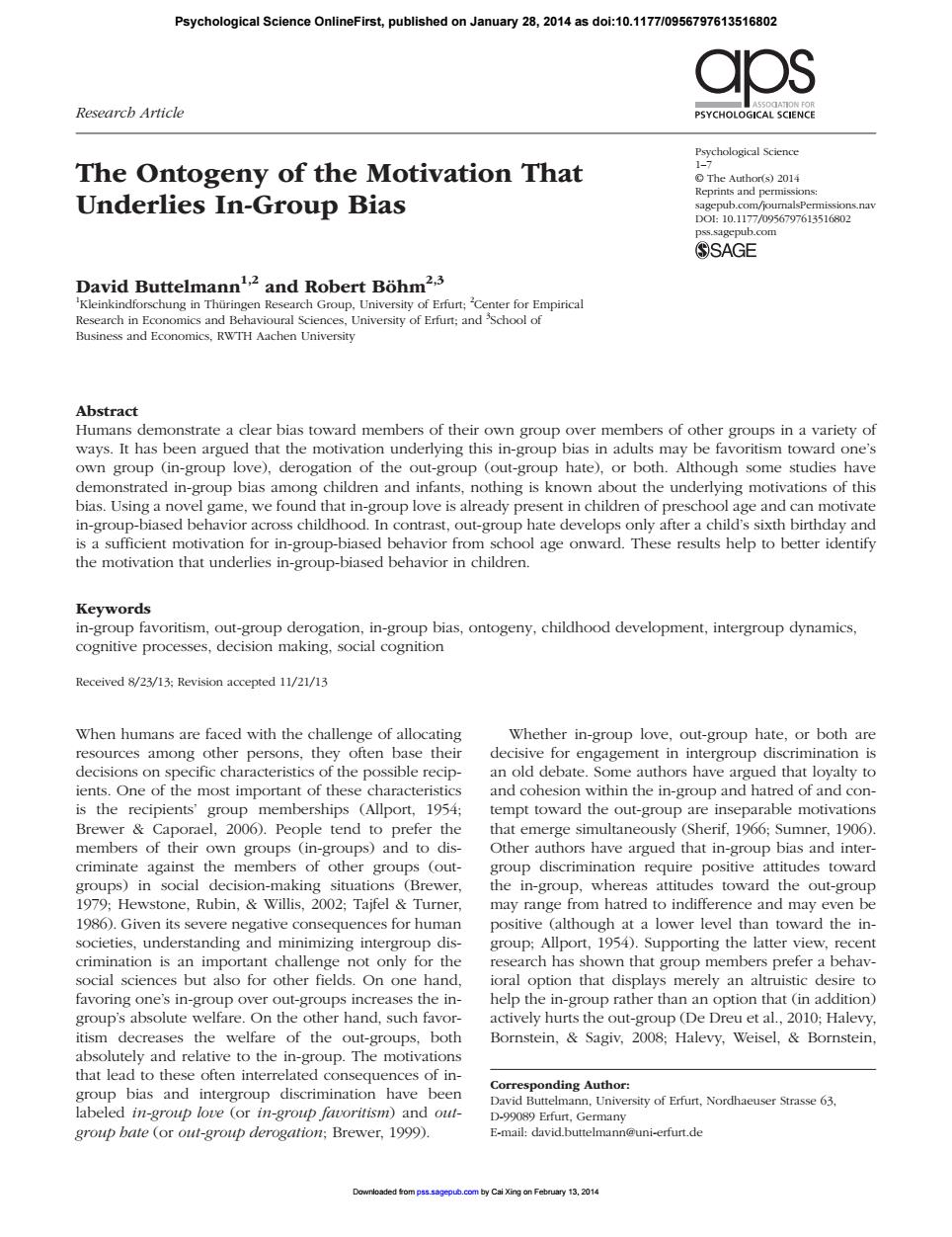正在加载图片...

Psychological Sclence OnlineFirst,published on January 28,2014 as dol:10.1177/0956797613516802 Research Article PSYCHO The Ontogeny of the Motivation That The Author(s)2014 Underlies In-Group Bias 0.1177 567y761351602 SAGE David Buttelmann'2 and Robert Bohm2> Business and Economics,RWTH Aachen University Abstract r bias toward membe s of thei own group over members of other groups in a variety of een argue rlying this in-group one: dem ated ir n hias ar hildren and infar othin is knon out the s of thi bias.Using a novel game,we found that in-group love is already present in children of preschool age and can motivate group-biased behavior across chilhood.n contrast,out-group hate develops only after a child's sixth birthday and the mnnmnaianorngop nool age onward. Keywords n bis,ny chiod developmnrp dyn Received /2/Revision accepted 11/21/13 Whether in-group love,out-group hate,or both are the e th or engagement and cohesion within the in-group and hatred of and con is the recipients'group memberships (Allport,1954; tempt toward the out-group are inseparable motivation Brewer Caporael emerge simultaneousl (Sherif,1966;Sumner 1906 0 ave arguec nat in-group sand inte ups)in social decision-making situations (Brewer, the in-group.whereas attitudes toward the out-grour 1979:Hewstone,Rubin,Willis,2002:Taifel Turner, may range from hatred to indifference and may even be 1986).Given its severe negative consequences for human positive (although at a lower leve than toward the in aing and m imizing intergroup group: Supporting the latter favoring one's in-group over out-groups increases the in- help the in-group rather than an option that (in addition) group's absolute velfare.On the other hand,such favo actively hurts the out-group (De Dreu et al..2010:Halevy it-groups, Bornstein,Sagiv,2008:Halevy,Weisel,Bornstein that lead to these ences of in- Corr nding author: mpm group bate (or out-group derogation:Brewer, 1999 1,201 Psychological Science 1–7 © The Author(s) 2014 Reprints and permissions: sagepub.com/journalsPermissions.nav DOI: 10.1177/0956797613516802 pss.sagepub.com Research Article When humans are faced with the challenge of allocating resources among other persons, they often base their decisions on specific characteristics of the possible recipients. One of the most important of these characteristics is the recipients’ group memberships (Allport, 1954; Brewer & Caporael, 2006). People tend to prefer the members of their own groups (in-groups) and to discriminate against the members of other groups (outgroups) in social decision-making situations (Brewer, 1979; Hewstone, Rubin, & Willis, 2002; Tajfel & Turner, 1986). Given its severe negative consequences for human societies, understanding and minimizing intergroup discrimination is an important challenge not only for the social sciences but also for other fields. On one hand, favoring one’s in-group over out-groups increases the ingroup’s absolute welfare. On the other hand, such favoritism decreases the welfare of the out-groups, both absolutely and relative to the in-group. The motivations that lead to these often interrelated consequences of ingroup bias and intergroup discrimination have been labeled in-group love (or in-group favoritism) and outgroup hate (or out-group derogation; Brewer, 1999). Whether in-group love, out-group hate, or both are decisive for engagement in intergroup discrimination is an old debate. Some authors have argued that loyalty to and cohesion within the in-group and hatred of and contempt toward the out-group are inseparable motivations that emerge simultaneously (Sherif, 1966; Sumner, 1906). Other authors have argued that in-group bias and intergroup discrimination require positive attitudes toward the in-group, whereas attitudes toward the out-group may range from hatred to indifference and may even be positive (although at a lower level than toward the ingroup; Allport, 1954). Supporting the latter view, recent research has shown that group members prefer a behavioral option that displays merely an altruistic desire to help the in-group rather than an option that (in addition) actively hurts the out-group (De Dreu et al., 2010; Halevy, Bornstein, & Sagiv, 2008; Halevy, Weisel, & Bornstein, 516802PSSXXX10.1177/0956797613516802Buttelmann, BöhmThe Ontogeny of In-Group Bias research-article2014 Corresponding Author: David Buttelmann, University of Erfurt, Nordhaeuser Strasse 63, D-99089 Erfurt, Germany E-mail: david.buttelmann@uni-erfurt.de The Ontogeny of the Motivation That Underlies In-Group Bias David Buttelmann1,2 and Robert Böhm2,3 1 Kleinkindforschung in Thüringen Research Group, University of Erfurt; 2 Center for Empirical Research in Economics and Behavioural Sciences, University of Erfurt; and 3 School of Business and Economics, RWTH Aachen University Abstract Humans demonstrate a clear bias toward members of their own group over members of other groups in a variety of ways. It has been argued that the motivation underlying this in-group bias in adults may be favoritism toward one’s own group (in-group love), derogation of the out-group (out-group hate), or both. Although some studies have demonstrated in-group bias among children and infants, nothing is known about the underlying motivations of this bias. Using a novel game, we found that in-group love is already present in children of preschool age and can motivate in-group-biased behavior across childhood. In contrast, out-group hate develops only after a child’s sixth birthday and is a sufficient motivation for in-group-biased behavior from school age onward. These results help to better identify the motivation that underlies in-group-biased behavior in children. Keywords in-group favoritism, out-group derogation, in-group bias, ontogeny, childhood development, intergroup dynamics, cognitive processes, decision making, social cognition Received 8/23/13; Revision accepted 11/21/13 Psychological Science OnlineFirst, published on January 28, 2014 as doi:10.1177/0956797613516802 Downloaded from pss.sagepub.com by Cai Xing on February 13, 2014